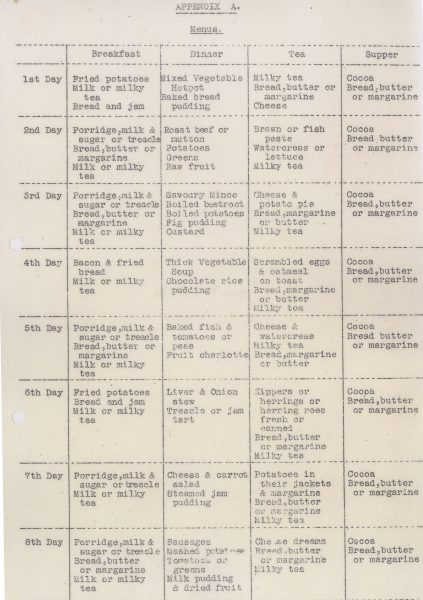Food in an evacuee hostel, 1940
Reference: BA/C/TC/4/3/626
Suggested age groups: KS2, KS3, KS4, Lifelong Learners
Subject areas: Cookery, History, Literacy
CONTEXT
During the Second World War children were evacuated from large cities and sent to the country or towns which were considered safer. Many children were evacuated from Newcastle to North Northumberland to places including Berwick, Wooler and Belford. Most children stayed with families but sometimes this wasn’t possible and so they stayed in hostels.
This is a menu for a hostel which was drawn up in 1940. It covers 8 days and suggests what can be served for breakfast, dinner tea and supper. It is quite varied and would at times have been more than the children would have received at home. It contains lots of protein and dinner was always a main course and a pudding.
ACTIVITIES
ACTIVITY 1
Background
During the Second World War children were evacuated from large cities and sent to the country or towns which were considered safer. Many children were evacuated from Newcastle to North Northumberland to places including Berwick, Wooler and Belford. Most children stayed with families but sometimes this wasn’t possible and so they stayed in hostels.
SEE
See: What did being evacuated mean during the Second World War?
See: Who might have evacuated during the Second World War?
See: Where is this menu from?
See: What does this menu call the different meals of the day?
See: What types of foods were served for each meal?
THINK
Think: Why were children evacuated during the Second World War?
Think: Who else, other than children, were evacuated during the Second World War?
Think: What types of areas were people evacuated from?
Think: What types of areas were people evacuated to?
Think: Why were children evacuated from Newcastle to North Northumberland?
Think: Why did some children have to stay in evacuee hostels?
Think: How would being evacuated make you feel? Would this change depending on if you were evacuated to a hostel or a host family?
Think: Do you think the children in the hostel were well fed?
Think: Do you think the meals in the hostel were similar to what the children would have eaten at home?
DO
Do: Do you live in an area that people would have been evacuated to or from? Take a survey of the people around you to find out the most popular answer. Plot the answers on a bar chart.
Do: Can you find evidence online of people being evacuated to or from your area?
Do: Look at the Imperial War Museum’s evacuation posters. Design a poster to encourage parents to evacuate their children.
Do: Write the script for a conversation between two evacuees, one who has been evacuated to a host family and one to a hostel. Think about their different experiences and how they may feel about them.
Do: Choose one of the dishes from the hostel menu, come up with a recipe for it and have a go at making it.
Resources
https://www.chroniclelive.co.uk/news/history/north-east-memories-day-world-11816858
https://www.iwm.org.uk/history/the-evacuated-children-of-the-second-world-war
https://www.nationalarchives.gov.uk/help-with-your-research/research-guides/evacuees/
https://www.thehistorypress.co.uk/articles/the-evacuation-of-children-during-the-second-world-war/
OTHER ONLINE RESOURCES
Imperial War Museum website, page about child evacuation: https://www.iwm.org.uk/history/the-evacuated-children-of-the-second-world-war
You Tube website, British Pathe film of children being evacuated: https://www.youtube.com/watch?v=ZPs8hbksOg8
BBC Teach website, includes radio report of evacuation and interviews with children and host families: https://www.bbc.co.uk/teach/school-radio/history-ks2-world-war-2-clips-ww2-evacuation-index/zvs3scw


